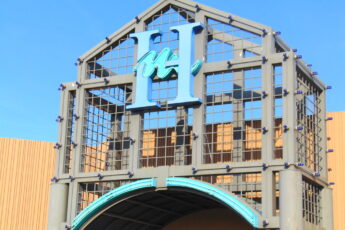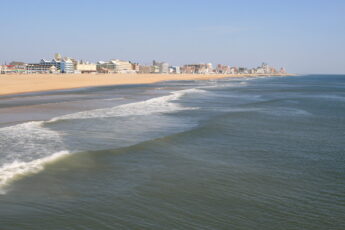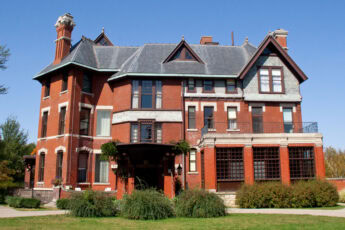Things to do in Plymouth, Massachusetts usually start with a rock. Maybe a replica ship. Maybe a costumed guide speaking in seventeenth-century English.
That’s the postcard version. What you’ll actually find is more textured. The town doesn’t just preserve its past – it moves inside it.
You can stand where the colonists stood, then eat local seafood, then watch barges drift past a state-run beach. It’s all there, pressed close together. That’s the point. Nothing’s tucked away or off-limits.
A Place Where the Past Is Always Present
Plymouth, Massachusetts, opened in 1620 as a colony and never closed the door.
The outlines of that first settlement are still visible, but what matters more is how they’ve been built into daily use.
A grist mill still grinds corn next to a walking path.
State parks run beside a canal dug for shipping routes.
A stone monument spells out civic ideals like Law, Education, and Faith – not as decoration, but as argument.
There’s no separation between the town’s history and how people spend time now.
Visitors move between centuries without leaving Main Street.
Some stand under the granite canopy that covers Plymouth Rock, placed there in 1920.
Others hike past fishing piers or sit in the town’s oldest museum, founded in 1824, flipping through ship logs and land records.
That’s what gives weight to the things to do in Massachusetts.
Not the age of the structures, but their function. History, in Plymouth, doesn’t sit still.
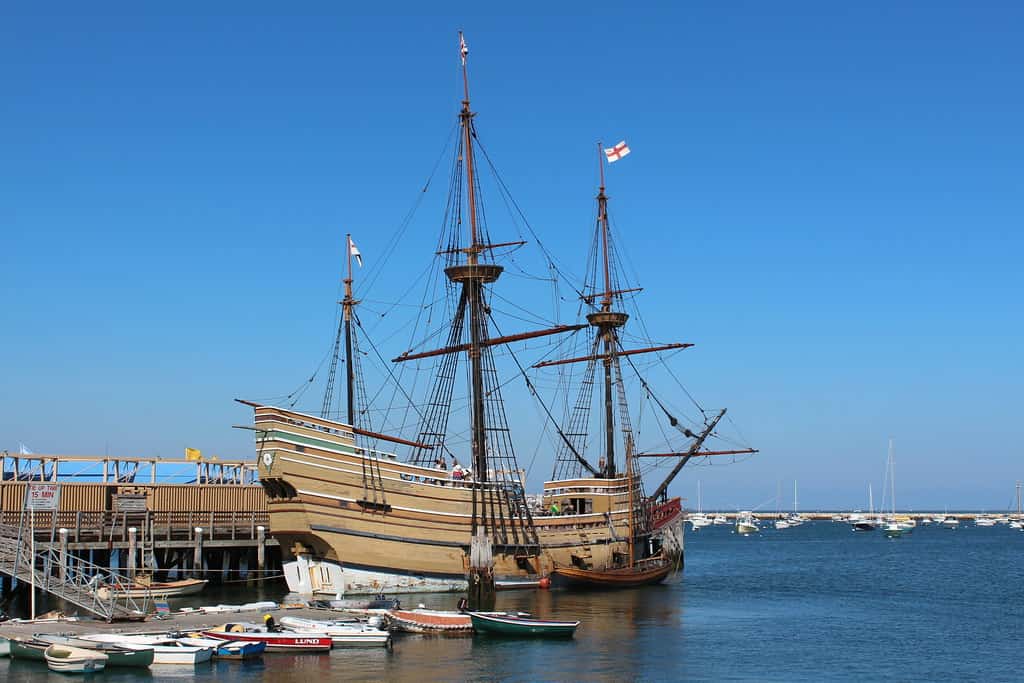
Plymouth Rock – A Symbol with a Story
The version most people know was shaped in the 19th century, but the idea took root earlier.
By 1741, townspeople had already identified a shoreline boulder as the Mayflower’s landing point.
In 1774, a group tried to move it. The rock split. The lower half stayed near the wharf; the top half was dragged to the town square.
In 1880, the two halves were reunited, the date “1620” was carved into the surface, and it was set at the base of a Victorian canopy.
Today, it rests under a granite portico designed by McKim, Mead and White.
Pilgrim Memorial State Park manages the site, and that canopy went up in 1920 as part of the Tercentenary celebration.
Nobody’s claiming it’s the literal spot. What it marks is the fixation.
For those tracking what to see in Massachusetts that still stirs national memory, this quiet piece of carved granite draws a steady line back.
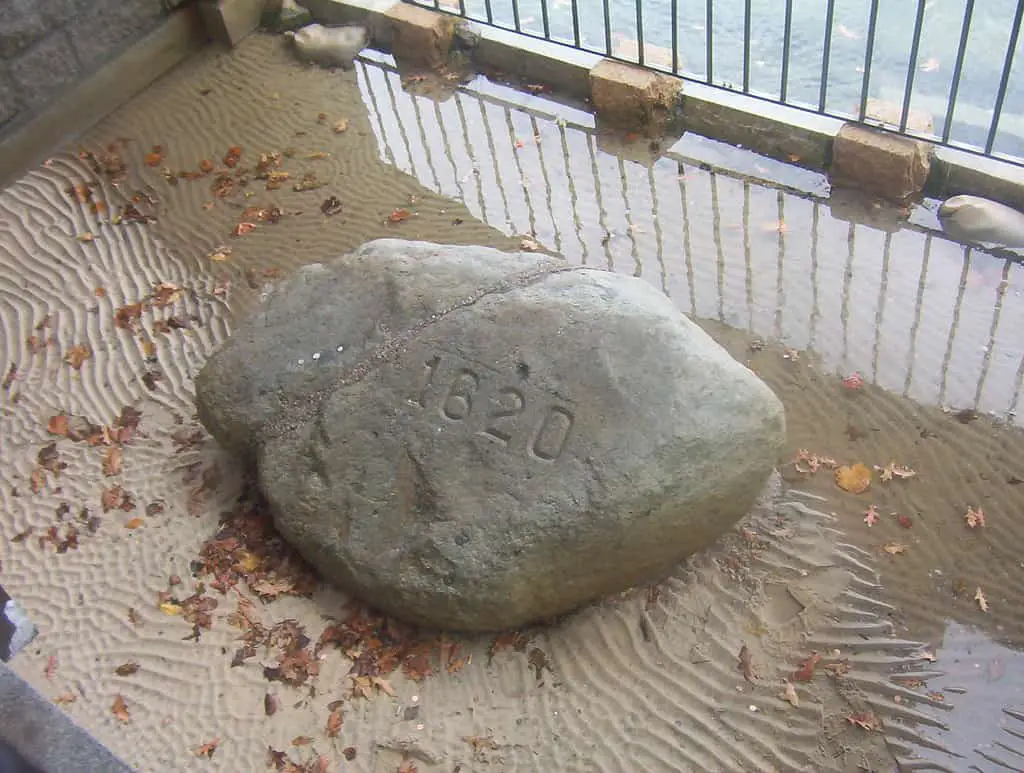
Plimoth Patuxet Museums – Living History
Launched in 1947, the site was built to make the 1600s legible.
Not with documents, but with land, crops, smoke, and voices.
The 17th-century English Village sits on the banks of the Eel River, recreated based on accounts like William Bradford’s Of Plymouth Plantation.
Walk through and you’ll see timber-framed homes, fenced gardens, and open hearths.
The detail stays tight because the museum runs its research team in parallel to its interpreters.
Next to it is the Historic Patuxet Homesite, where staff interpret the seasonal life of the Wampanoag using Indigenous knowledge, not colonial texts.
Both halves work together. One shows what was brought across the Atlantic. The other shows what was already here.
Of all the places to visit in Massachusetts with built-in contrast, few walk that line more precisely.

National Monument to the Forefathers – Ideals in Stone
Installed in 1889 and reaching 81 feet high, this granite column isn’t tucked away on some government lawn.
It sits wide open on Allerton Street, surrounded by trees and quiet.
The design came from Hammatt Billings, who sketched it two decades before it was carved.
At the center stands Faith, holding a Bible and pointing upward.
Around her, four seated figures represent Morality, Law, Education, and Liberty.
Each one is flanked by bas-reliefs – a printing press, a schoolroom, a courtroom – meant to show what those ideals looked like in action.
The stone came from Hallowell, Maine. The inscriptions came from the cultural debates of the 1850s.
The monument wasn’t finished until the 1880s.
Visitors looking for what to do in Massachusetts with a straight line from Puritan roots to 19th-century civic ambition tend to end up here.
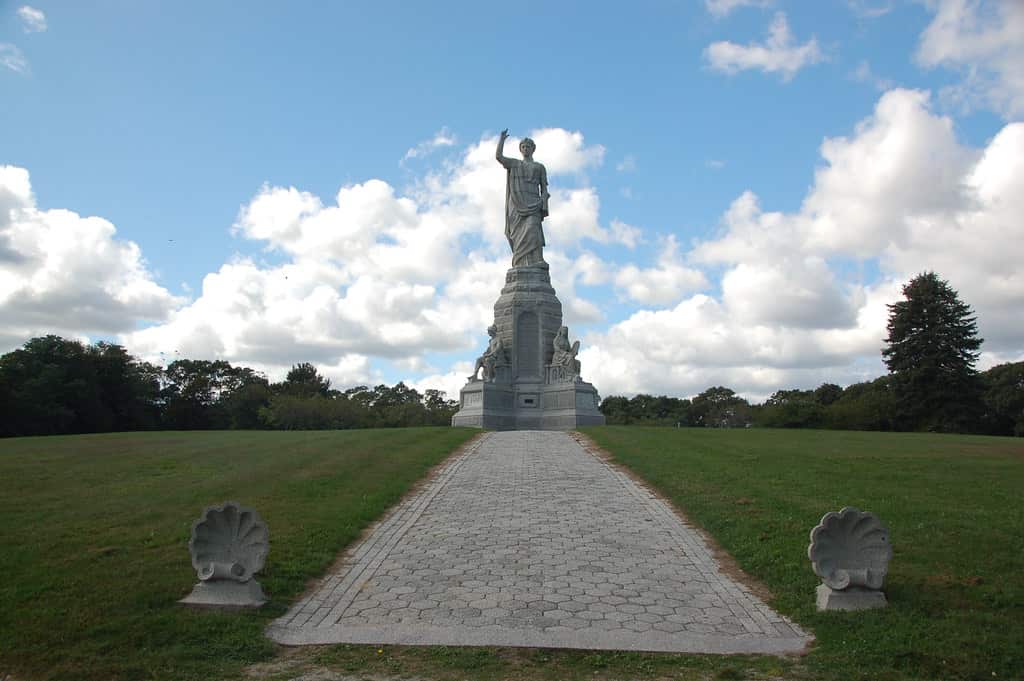
Scusset Beach State Reservation – Coastal Recreation
Set on the western edge of Cape Cod Bay, Scusset Beach opened in the 1950s on land shaped by earlier military use.
Before the state park, Camp Edwards’ coastal defense site stood nearby, monitoring the mouth of the canal.
Today, it’s known less for history than access.
There’s a mile and a half of beach, paved campsites for RVs, and access to the South Jetty – a quarter-mile stretch of boulders that runs out into the water, drawing walkers and striped bass anglers.
The park sits at the northern end of the Cape Cod Canal.
So cargo ships pass as people swim. The Department of Conservation and Recreation manages the site.
Among outdoor attractions in Massachusetts that hold multiple uses – shipping, fishing, camping, shoreline access – this one layers its functions cleanly.
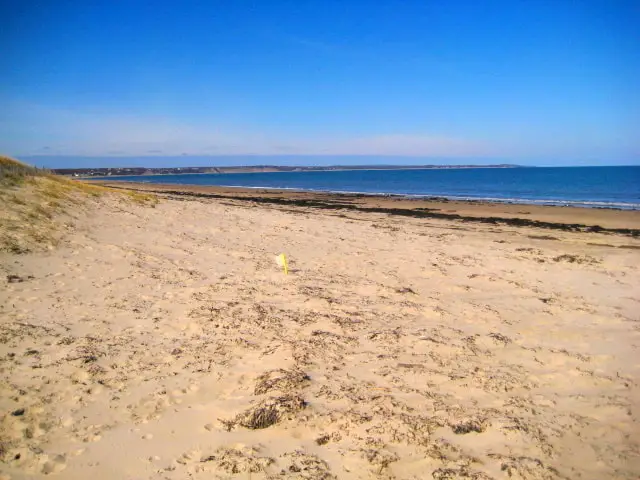
Plimoth Grist Mill – Milling Through Time
Reconstructed on the same brook where John Jenney built the original in 1636, the Plimoth Grist Mill doesn’t just show how corn was ground.
It runs the stone. It bags the meal. It sells it on-site.
The building was rebuilt in the 1970s using period methods and sits directly above Town Brook, a waterway that fed the colony’s earliest industry.
Visitors see the turning wheel and the granite millstones.
Docents explain how water power gets transferred to grain, how coarseness is adjusted, and how seasonal flow shapes production.
The mill is part of the Plimoth Patuxet system but holds its own.
For travelers mapping out things to do in Massachusetts with working parts from the colonial era, this one stands apart.
It’s still tied to function, not just memory.
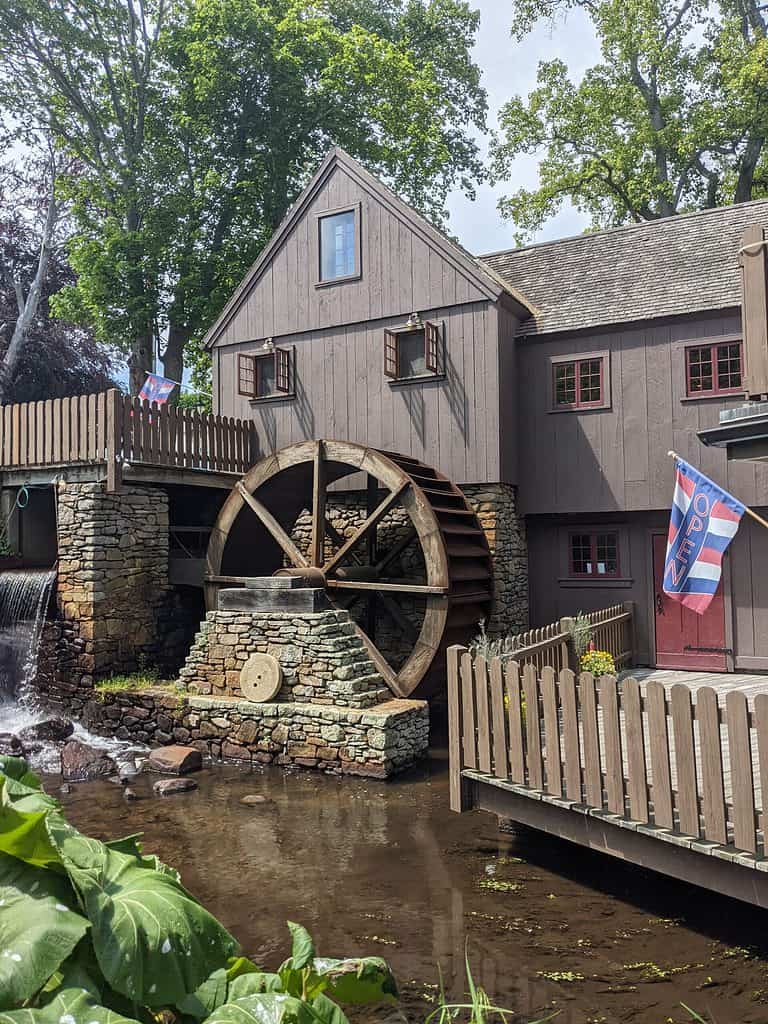
Pilgrim Hall Museum – Artifacts and Archives
Pilgrim Hall opened in 1824, right on Court Street, and never tried to be grand.
The rooms are modest, the lighting quiet, the glass cases closed.
But inside are the objects people came across an ocean to keep – and kept.
Bradford’s Bible. Standish’s sword. A cradle pulled off the Mayflower. The material doesn’t need drama.
What the museum offers is compression. A small space with primary evidence.
Most of it came through local families or the Pilgrim Society, which has managed the collection since the 19th century.
The sequence isn’t flashy. But the facts are dense, and the framing stays tight.
Anyone tracing early settlement patterns or wondering where to go in Massachusetts for documents and physical memory ends up here eventually.
You don’t wander through this museum. You move slowly because nearly every piece has a name, a ship, and a reason it was carried.
Mayflower II – A Transatlantic Replica
The replica came later. Mayflower II launched from Brixham in 1957, crossing the Atlantic on its own sail.
No motors. No tricks. It docked in Plymouth to mark wartime alliance – and to restore a lost dimension of the town’s origin story.
The ship runs 106 feet, oak hull, hemp rigging, square sails. It looks heavy, and it is.
Built by English shipwrights using 17th-century methods, it mirrors the rough math of the original: cramped quarters, limited light, low ceilings.
The hold smells like wood, salt, and tar.
Moored at Pilgrim Memorial State Park, the vessel is managed by Plimoth Patuxet Museums.
It’s one of the few places to visit in Massachusetts where you can walk straight into the scale of early migration.
No need to imagine what crossing felt like. It’s there under your feet.
Brewster Gardens – A Riverside Retreat
Brewster Gardens reads like an aside on the map. A narrow band following Town Brook from Burial Hill to the harbor.
But walk it and you get layers. The brook powered early mills. The land held 1620 garden plots.
Today, it’s grass, trees, and stone markers arranged with care.
There’s a bridge, a few sculptures, a clear run of water that still draws herring in spring.
It’s framed more like a passage than a park. Locals use it to cut across town.
Visitors follow it to watch the slope of history, from colonial agriculture to modern restoration.
For those sorting out things to do in Massachusetts that connect history to street level, Brewster Gardens lands quietly but sharply.
Nothing is staged. Nothing shouts. The past is just there, under tree roots and flowing water.
Plymouth Waterfront – A Hub of Activity
The harbor doesn’t try to hide its work. Fishing boats lean at the dock.
Ferries run their routes. Restaurants face the water like they’ve always been there.
Pilgrim Memorial State Park anchors the south end.
The rest stretches north, piers, green space, food trucks, and occasional music.
You can follow the seawall or cut through Brewster Gardens.
Rent a paddleboard. Eat fried clams. Watch a high school band rehearse by the pavilion.
Most days, the energy comes from overlap. Locals are running errands. Tourists snapping photos of a rock.
For anyone asking what to see in Massachusetts that doesn’t need interpreting – just space, time, and motion – this is the place.
You’re on the edge of a founding story, with sunscreen in your bag and salt on your shoes.
FAQ
How do I spend a day in Plymouth?
Start at Pilgrim Memorial State Park. See Plymouth Rock, walk the waterfront, then board Mayflower II.
Follow Town Brook to Brewster Gardens and stop by the Plimoth Grist Mill.
In the afternoon, visit Plimoth Patuxet Museums or Pilgrim Hall.
Finish with seafood by the harbor.
Is Plymouth, Massachusetts, worth visiting?
Yes—if you’re interested in early American history, that’s still embedded in streets and structures.
The town doesn’t just mark its past, it runs on it.
You’ll find walkable museums, working mills, and real public spaces that tie the past to the present without pretense.
What to do in downtown Plymouth, MA?
Walk Water Street. Stop at Pilgrim Hall Museum, browse the shops, and cut through Brewster Gardens.
Grab lunch by the harbor. From there, you can reach the waterfront, the rock, or catch seasonal events without leaving the block.
What did people do for fun in Plymouth?
In the 1600s, leisure followed work. People fished, hunted, played simple games, and gathered for meals or church days.
By the 1800s, promenades, lectures, and public festivals became common.
Today, you’ll find concerts, boat tours, and quiet shoreline paths.
What is Plymouth, MA, famous for?
Plymouth is known as the landing place of the Mayflower in 1620 and the site of one of the first English colonies in North America.
It’s also known for Plymouth Rock, the Pilgrims’ legacy, and the blend of historical and coastal spaces still open to the public.
🍀




